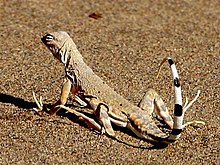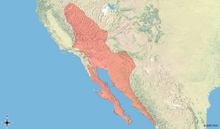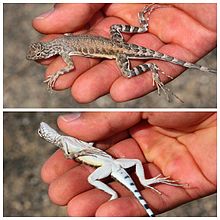Zebra-tailed lizard
| Callisaurus draconoides | |
|---|---|

| |
| A zebra-tailed lizard | |
| Scientific classification | |
| Domain: | Eukaryota |
| Kingdom: | Animalia |
| Phylum: | Chordata |
| Class: | Reptilia |
| Order: | Squamata |
| Suborder: | Iguania |
| Family: | Phrynosomatidae |
| Genus: | Callisaurus Blainville, 1835 |
| Species: | C. draconoides
|
| Binomial name | |
| Callisaurus draconoides Blainville, 1835
| |

| |
Zebra-tailed lizards (Callisaurus) are a genus of phrynosomatid lizards endemic to the southwestern United States and northwestern Mexico.
Habitat
They live in open desert with fairly hard-packed soil, scattered vegetation and scattered rocks, typically flats, washes and plains.
Description
They range in size from 2.5 to 4 inches (64 to 102 mm) in snout-to-vent length. These lizards are grey to sandy brown, usually with series of paired dark gray spots down their backs, becoming black bands on the tails. The underside of tail is white with black bands. Males have a pair of black blotches on their sides, extending to blue patches on their bellies. Females have no blue patches, and the black bars are either faint or completely absent.

Behavior
They are diurnal and alert. They rise early and are active in all but the hottest weather. During the hottest times of day, lizards may stand alternately on two legs, switching to the opposite two as needed in a kind of dance. When threatened they will run swiftly with their toes curled up and tails raised over their backs exposing the stripes. When stopped, they wag their curled tails side-to-side to distract predators. They can even run on their hind legs for short distances. In areas of creosote scrub this lizard seems to reach highest densities, around 4.8 to 6.0 individuals per acre (600 to 800 m² per lizard). This lizard burrows into fine sand for retreat at night and usually seeks day shelter in the shade of bushes. They are also known to burrow under sand for safety when being chased by predators.
Reproduction
In summer, 2 to 8 eggs are typically laid, hatching anywhere from July to November. However, more than 1 clutch can be laid during a season. Eggs are laid, presumably, in friable, sandy soil. Being a prey species for many animals, including birds, other lizards, and mammals, they have a fairly high reproductive rate.
Diet
It feeds on a variety of prey from insects, such as moths, ants and bees, as well as spiders and other smaller lizards. Its diet occasionally includes vegetation, such as spring buds and flowers.
Geographic range
The zebra-tailed lizard is common and widely distributed throughout the southwestern United States, ranging from the Mojave and Colorado deserts north into the southern Great Basin.
Taxonomy
The genus Callisaurus is monotypic, containing only one species, Callisaurus draconoides. The numerous subspecies are:
- Bogert's zebra-tailed lizard, C. d. bogerti Martin del Campo, 1943
- Short-footed zebra-tailed lizard, C. d. brevipes Bogert & Dorson, 1942
- Carmen Island zebra-tailed lizard, C. d. carmenensis Dickerson, 1919
- Viscaino zebra-tailed lizard, C. d. crinitus Cope, 1896
- common zebra-tailed lizard, C. d. draconoides Blainville, 1835
- Sonoran zebra-tailed lizard, C. d. inusitanus Dickerson, 1919
- Nevada zebra-tailed lizard, C. d. myurus Richardson, 1915
- Mojave zebra-tailed lizard, C. d. rhodostictus Cope, 1896
- Angel Island zebra-tailed lizard, C. d. splendidus Dickerson, 1919
- eastern zebra-tailed lizard, C. d. ventralis (Hallowell, 1852)[1]
References
- ^ The Reptile Database. www.reptile-database.org.
- "Callisaurus draconoides". Integrated Taxonomic Information System. Retrieved 6 February 2006.
- National Audubon Society Field Guide to North American Reptiles and Amphibians. Knopf, Chanticleer Press Ed edition, (1979). ISBN 0-394-50824-6
- Halliday, Tim and O'Shea, Mark; Smithsonian Handbooks: Reptiles and Amphibians. Dorling Kindersley Publishing (2002). ISBN 0-7894-9393-4
